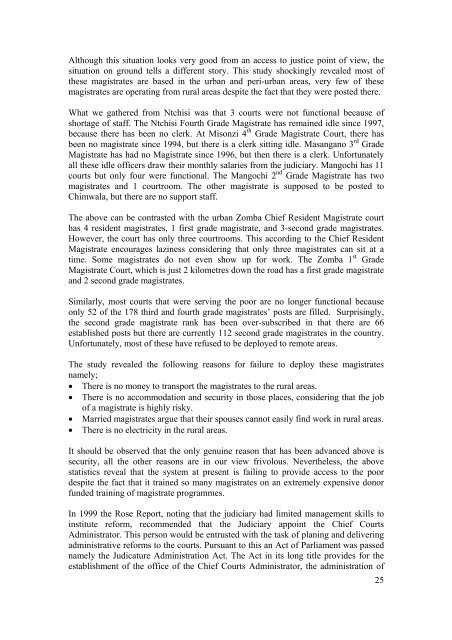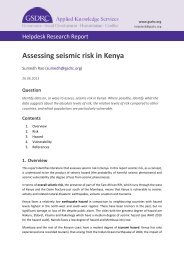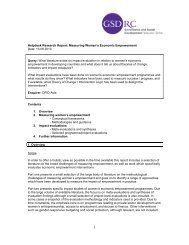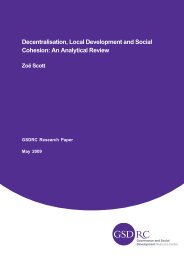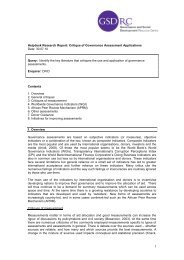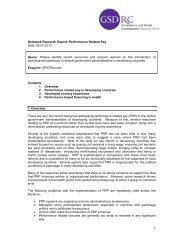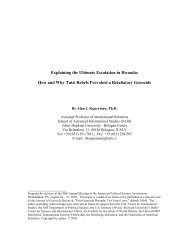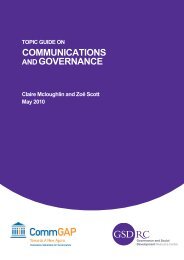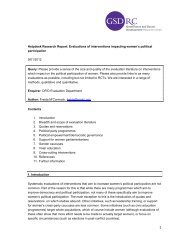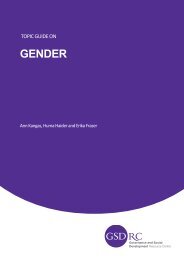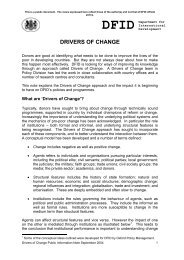ACCESS TO JUSTICE FOR THE POOR OF MALAWI? AN ... - GSDRC
ACCESS TO JUSTICE FOR THE POOR OF MALAWI? AN ... - GSDRC
ACCESS TO JUSTICE FOR THE POOR OF MALAWI? AN ... - GSDRC
- No tags were found...
Create successful ePaper yourself
Turn your PDF publications into a flip-book with our unique Google optimized e-Paper software.
Although this situation looks very good from an access to justice point of view, thesituation on ground tells a different story. This study shockingly revealed most ofthese magistrates are based in the urban and peri-urban areas, very few of thesemagistrates are operating from rural areas despite the fact that they were posted there.What we gathered from Ntchisi was that 3 courts were not functional because ofshortage of staff. The Ntchisi Fourth Grade Magistrate has remained idle since 1997,because there has been no clerk. At Misonzi 4 th Grade Magistrate Court, there hasbeen no magistrate since 1994, but there is a clerk sitting idle. Masangano 3 rd GradeMagistrate has had no Magistrate since 1996, but then there is a clerk. Unfortunatelyall these idle officers draw their monthly salaries from the judiciary. Mangochi has 11courts but only four were functional. The Mangochi 2 nd Grade Magistrate has twomagistrates and 1 courtroom. The other magistrate is supposed to be posted toChimwala, but there are no support staff.The above can be contrasted with the urban Zomba Chief Resident Magistrate courthas 4 resident magistrates, 1 first grade magistrate, and 3-second grade magistrates.However, the court has only three courtrooms. This according to the Chief ResidentMagistrate encourages laziness considering that only three magistrates can sit at atime. Some magistrates do not even show up for work. The Zomba 1 st GradeMagistrate Court, which is just 2 kilometres down the road has a first grade magistrateand 2 second grade magistrates.Similarly, most courts that were serving the poor are no longer functional becauseonly 52 of the 178 third and fourth grade magistrates’ posts are filled. Surprisingly,the second grade magistrate rank has been over-subscribed in that there are 66established posts but there are currently 112 second grade magistrates in the country.Unfortunately, most of these have refused to be deployed to remote areas.The study revealed the following reasons for failure to deploy these magistratesnamely;• There is no money to transport the magistrates to the rural areas.• There is no accommodation and security in those places, considering that the jobof a magistrate is highly risky.• Married magistrates argue that their spouses cannot easily find work in rural areas.• There is no electricity in the rural areas.It should be observed that the only genuine reason that has been advanced above issecurity, all the other reasons are in our view frivolous. Nevertheless, the abovestatistics reveal that the system at present is failing to provide access to the poordespite the fact that it trained so many magistrates on an extremely expensive donorfunded training of magistrate programmes.In 1999 the Rose Report, noting that the judiciary had limited management skills toinstitute reform, recommended that the Judiciary appoint the Chief CourtsAdministrator. This person would be entrusted with the task of planing and deliveringadministrative reforms to the courts. Pursuant to this an Act of Parliament was passednamely the Judicature Administration Act. The Act in its long title provides for theestablishment of the office of the Chief Courts Administrator, the administration of25


